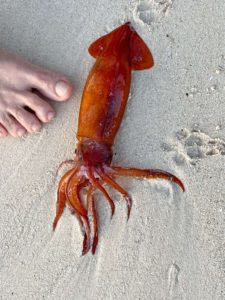
Our beached squid that held a surprise. My paw is on the left, our dog Pixel’s paw print on the right. ©Susan Scott
May 4, 2021
During a recent morning walk on Lanikai Beach, Craig and I came upon a visiting couple crouched over a mass at the waterline. The tourists didn’t know the creature’s identity, but we did. It was a perfectly intact squid.
“Will you hold it up?” I asked Craig, as I pulled my camera from my pocket. “I want a shot of that eye.”
The second Craig’s fingers gripped the squid body, the creature, which we assumed was dead, wrapped its suction cupped tentacles around Craig’s hand and clamped down.
“It’s biting me!” Craig said, as he worked to pry off the tentacles. “Ouch. It bit me again!”
Finally free of the suckers, Craig dropped the squid to the sand. The four of us gawked at the wounds on Craig’s finger, and then at the once-again motionless squid.
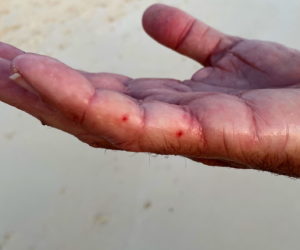
Craig’s squid bites. ©Susan Scott
“Well, that was exciting,” Craig said.
Squids are always exciting, dead or alive. They’re also mysterious.
The world’s oceans host about 500 species of squid (separate from octopuses, called squid by some Hawaii residents.) These odd-looking ancient marine animals have existed for over 500 million years, ranging in length, stretched out, from about one-inch-long to 43-feet-long. Based on the size of squid beaks found in sperm whale stomachs, scientists believe giant squids can reach an astonishing 66 feet long.
Speaking of beaks, squid, like their octopus and cuttlefish cousins, have mouths called beaks. The name comes from parrot beaks, since both have sharp tips powered by jaws strong enough to crush bone.
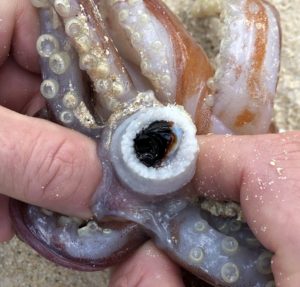
The black mass at the center is the so-called beak of another squid we found on the same part of the Lanikai Beach earlier this year. That squid, below, was larger (and safely dead.) ©Susan Scott
Ten sucker-bearing arms surround a squid’s mouth. While swimming, the animal presses its arms together to help it steer. When a squid finds food (most anything that swims), its two longest arms shoot out and drag the prey toward the mouth. The eight shorter arms hold it there as the formidable beak clamps down, and glands release a fatal toxin. Fortunately, our live squid didn’t have time to inject toxin into Craig’s hand, and his wounds were minor.
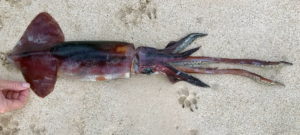
The two long tentacles at right are grabbers that draw prey within reach of the 8 shorter tentacles. ©Susan Scott
Squids’ muscular bodies are prime food for meat-eating fish, dolphins, toothed whales, and people. That means squids are also prime prey. Being vulnerable to predators, squids have cryptic lifestyles, swimming to the black depths of offshore waters during the day, and rising at night to hunt in the dark.
Although most squid species live offshore, Hawaii hosts two that prefer inshore. The little bobtail squid, found only in Hawaii waters, is 2-to-3 inches long. Its brown body spots are often mixed with green and blue spots that glow in the dark.
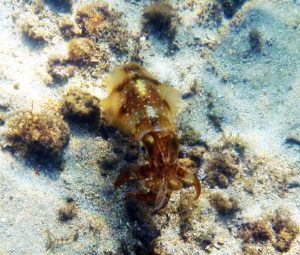
A 2-inch bobtail squid I found swimming in 3 feet of water off a Waialua beach. ©Susan Scott
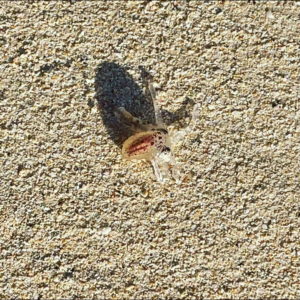
My neighbor, Marya Grambs, found and photographed this tiny bobtail squid on Lanikai Beach the same week we found the live squid.
The other squid we sometimes see in Hawaii’s shallow waters is the foot-long bigfin squid, a species with two rippling fins that form an oval along the length of the body. I’ve snorkeled with these squid at Hanauma Bay.
Squids live fast and die young, the life span of most being nine months to a year. The rare beached squids I’ve found throughout the Pacific were likely at the end of their lifespans, and washed ashore before a predator spotted them and gobbled them up. Clearly, though, our Lanikai squid had plenty of life left in it.
I picked the squid up from the safe end and got my picture of its eye. Then we returned the stranded animal to its ocean home, where it disappeared in a cloud of black ink.
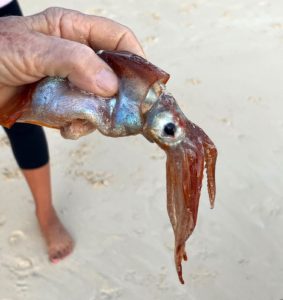
Squids’ large eyes help them find prey in their always-dark world. ©Susan Scott
“What did you say that was again?” the visiting woman said, unfamiliar with the creature’s form, and apparently with the word squid.
“Calamari,” I said.
That word she knew.
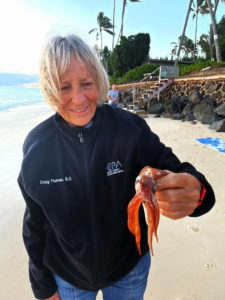
That squid made my day, as did Craig. He not only lent me his jacket for our early morning beach walk, he also got bitten for me.